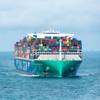Eye on Design: Cooperative Research Ships
There can be few organizations that bring together so many sectors of the maritime industry in a non-competitive environment. Cooperative Research Ships (CRS), 40+ years and still going strong, tackles problems of common Interest and furthers research. The practical knowledge and tools that emerge from CRS are then used by its members. Initiated by MARIN in 1969, the organization is a true cooperative. All of its members are actively involved, equally fund the research work and then they directly get the benefits. Results are exclusively available for the CRS members. Currently, 23 organizations are involved in CRS, including leading shipyards, suppliers, classification societies, navies, research organizations and one of the largest ship operators. MARIN plays a facilitating role by taking care of the chairmanship and secretariat. CRS has a simple and democratic organization, with as little bureaucracy as possible. Anyone can come up with an idea for research. About a dozen items are selected and voted on at the mid-year Open Meeting and then a limited number of proposals are presented at the Annual General Meeting in December. Each year, three new projects are chosen to run alongside the existing ones. A seven-strong Steering Group organizes the two main annual CRS meetings, monitors working group progress and facilitates the flow of information and creation of research proposals. One representative from each industry segment sits on the Steering Group for two years. For each working group, organizations can choose to be a full member, which entails active involvement, or a corresponding member. All members can obtain research updates through frequent meetings and through access to the CRS website at www.crships.org. Members have to be in agreement with new candidates but already many competitors work together in CRS. Often they find the informal contacts very useful. CRS also provides a training ground for young engineers. They not only learn the technical side but also about working in international teams. As of 2010, each member will pay 60,000 Euro each year for funding between 10 to fourteen projects. Roughly 100,000 to 400,000 Euro over a three-year period is provided for each project.
By the members, for the members
Collectively, CRS possesses a wide range of expertise and facilities, ranging from practical design, engineering, construction and operation, to fundamental research in many maritime related areas. This is used to optimum advantage in carrying out the work programme. Developments in the maritime industry can be followed up directly, as is illustrated by the ongoing projects on performance in extreme conditions (ice), energy and emission, survivability and broadband propeller noise. Although working groups run for around three years, in reality most build on past CRS research. For instance, in the area of seakeeping, CRS has worked on related projects for over two decades so there is a continuous accumulation of knowledge and tools. Knowledge is also combined effectively between projects, e.g. by bringing together the working groups on propulsion and manoeuvring. These features are unique in the R&D world. Over the decades there have been many highlights. New insights have been gained into complex phenomena related to cavitation and broadband excitation, using combined numerical and experimental techniques. The effects of propeller-induced vibrations is a big problem for yards and owners. The current PROCAL tool development will allow CRS members to predict with accuracy the propeller loads and eventually, cavitation and impact on ship response. The programs PRECAL and PRETTI and previous slamming and green water on deck research, provide vital building blocks into seakeeping researchin combination with structural dynamics.
The future starts today
CRS has been specialized in many areas until now but it makes sense to integrate a number of areas, for instance, propulsion research with seakeeping and manoeuvring research. Such a multi-disciplinary approach can then be used for improving design and operational performance. At the last Open Meeting, CRS has identified several new areas for research, including the development of a CFD toolset, propeller and shaft loads, bow thrusters and trimaran design. There will always be plenty of technical challenges to ensure that CRS has enough work for the next 40 years!
(As published in the October 2011 edition of Maritime Reporter + Engineering News - www.marinelink.com)














